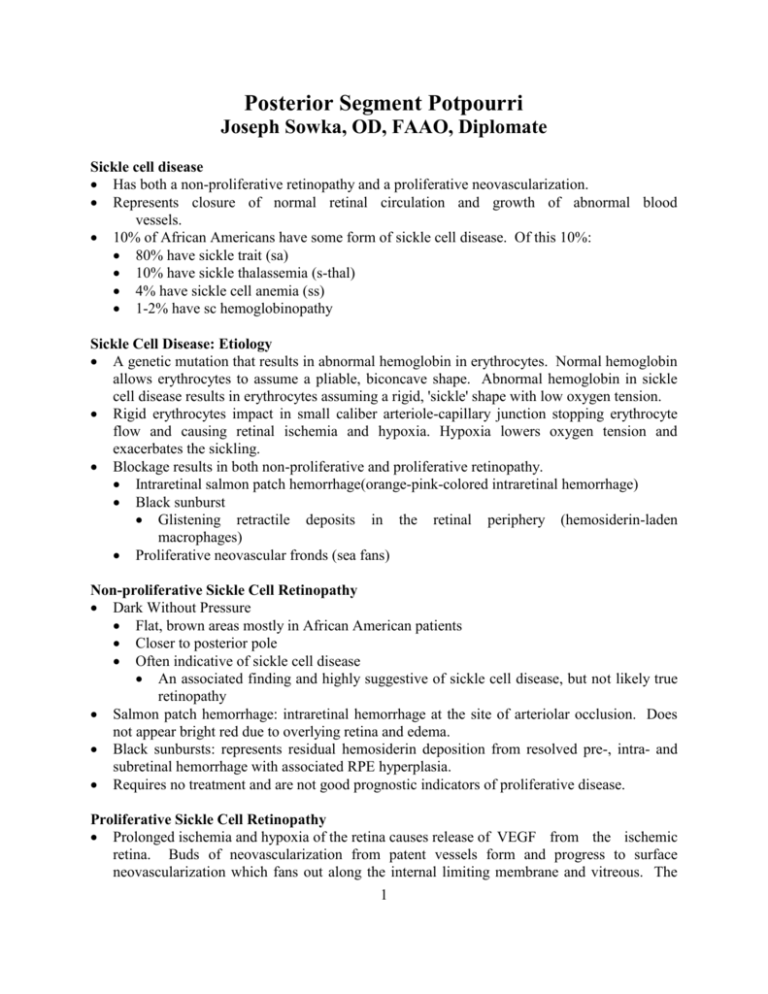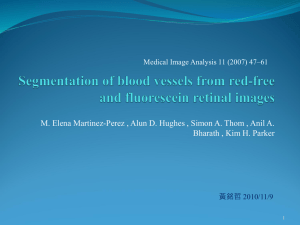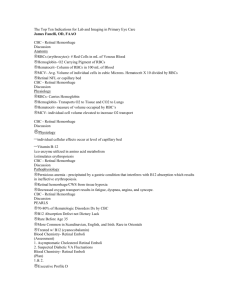Retinal Potpourri
advertisement

Posterior Segment Potpourri Joseph Sowka, OD, FAAO, Diplomate Sickle cell disease Has both a non-proliferative retinopathy and a proliferative neovascularization. Represents closure of normal retinal circulation and growth of abnormal blood vessels. 10% of African Americans have some form of sickle cell disease. Of this 10%: 80% have sickle trait (sa) 10% have sickle thalassemia (s-thal) 4% have sickle cell anemia (ss) 1-2% have sc hemoglobinopathy Sickle Cell Disease: Etiology A genetic mutation that results in abnormal hemoglobin in erythrocytes. Normal hemoglobin allows erythrocytes to assume a pliable, biconcave shape. Abnormal hemoglobin in sickle cell disease results in erythrocytes assuming a rigid, 'sickle' shape with low oxygen tension. Rigid erythrocytes impact in small caliber arteriole-capillary junction stopping erythrocyte flow and causing retinal ischemia and hypoxia. Hypoxia lowers oxygen tension and exacerbates the sickling. Blockage results in both non-proliferative and proliferative retinopathy. Intraretinal salmon patch hemorrhage(orange-pink-colored intraretinal hemorrhage) Black sunburst Glistening retractile deposits in the retinal periphery (hemosiderin-laden macrophages) Proliferative neovascular fronds (sea fans) Non-proliferative Sickle Cell Retinopathy Dark Without Pressure Flat, brown areas mostly in African American patients Closer to posterior pole Often indicative of sickle cell disease An associated finding and highly suggestive of sickle cell disease, but not likely true retinopathy Salmon patch hemorrhage: intraretinal hemorrhage at the site of arteriolar occlusion. Does not appear bright red due to overlying retina and edema. Black sunbursts: represents residual hemosiderin deposition from resolved pre-, intra- and subretinal hemorrhage with associated RPE hyperplasia. Requires no treatment and are not good prognostic indicators of proliferative disease. Proliferative Sickle Cell Retinopathy Prolonged ischemia and hypoxia of the retina causes release of VEGF from the ischemic retina. Buds of neovascularization from patent vessels form and progress to surface neovascularization which fans out along the internal limiting membrane and vitreous. The 1 sea fan indicates risk of vitreous hemorrhage with subsequent fibrosis and tractional retinal detachment. 5 stages of proliferative sickle retinopathy: 1. Arteriolar occlusion-Between ora and equator 2. A-V anastomosis to bypass occlusion 3. Surface neo and sea fans 4. Vitreous hemorrhage 5. Tractional retinal detachment Slow rate of progression. Sickle cell retinopathy may be dormant for a decade and then progress quickly. Age generally correlates to the stage of the disease. Occurs primarily in the 3rd and 4th decade, but has been known to occur in the 2nd decade. Sickle Cell Retinopathy: Treatment Systemic rule out of sickle cell disease if retinopathy typical of sickle cell is discovered in patients with no previous known medical history. Consider the association of dark without pressure in black patients with sickle cell disease. No treatment for non-proliferative changes Sector scatter photocoagulation for proliferative changes and areas of non-perfusion. A small, randomized study showed that laser was associated with a reduction in the incidence of vitreous hemorrhage and prolonged loss of VA Clinical Pearl: Sea frond neovascularization is characteristic of sickle cell retinopathy. Coat's Disease and Leber’s Miliary Aneurysm A specific exudative retinopathy caused by telangiectasis of the retinal vessels. Final result is often exudative retinal detachment. Retinal telangiectasias: a rare, idiopathic vascular anomaly consisting of the following: Dilation of the retinal vessels Tortuous retinal vessels Multiple aneurysms Varying degree of leakage Deposition of lipid exudates and hemorrhages Not associated with any other systemic or ocular conditions On the basis of telangiectasias, Coat's is indistinguishable from Leber's miliary aneurysm. Coat's is exudative, Leber’s is not. Leber’s miliary aneurysm Localized cluster of dilated capillaries and aneurysms and telangiectasia. Very similar to Coat’s disease, but there is no exudation and minimal leakage Most likely a variant of Coat’s disease When massive exudation results from any disease, it is termed Coat’s response. Coat's Disease: Etiology Formation of telangiectasis and breakdown of the inner blood-retinal barrier are the 2 fundamental causes of all changes found in coat's disease. Coat's Disease: Clinical Appearance Broad spectrum of features Ranges from mild to massive aneurysmal exudation. Vitreous hemorrhage Capillary changes including increased permeability and non-perfusion. Retinal edema Intra- and sub-retinal mounds of retinal exudation. Serous retinal detachment Because of capillary closure at the telangiectasis, retinal neovascularization with subsequent vitreous hemorrhage and traction detachment can also occur. Coat's Disease: Clinical Presentation Predominately a unilateral presentation affecting males (85%) between the ages of 18 months and 18 years. Affects the retinal periphery with a predilection for the superior and superiortemporal quadrant. One quarter of cases are detected on routine examination. Prognosis is guarded. There is a gradual progression with increasing exudation over time. Final result can be macular edema and/ retinal detachment. Treatment is aimed at eliminating abnormal blood vessels. Coat's Disease: Treatment Progresses to total retinal detachment if untreated Laser photocoagulation or cryoretinopexy to area of telangiectasia/exudation for thermal necrosis of vessels. Scleral buckle Pain relief for blind eyes Clinical Pearl: Leber’s miliary aneurysm is most likely Coat’s disease without the leakage. Clinical Pearl: Coat’s disease is one of many reasons why you should routinely dilate asymptomatic young patients. Choroidal Nevus Benign melanocytic tumor of the posterior uvea. A choroidal tumor consisting of atypical but benign melanocytes. This is the most common intraocular tumor encountered in clinical practice. However, do not use the word tumor when discussing nevi with patients. Ranges from 1-2% in clinical studies to 6.5% in autopsy studies. Extremely rare in children. Choroidal Nevus: Clinical Appearance Appears as a flat or minimally elevated slate gray or green lesion with distinct, but not well demarcated borders. Pigmentation is variable and may be amelanotic. 3 Nevi can range from 1/3 DD to 3 DD (some have reached 6 DD). Usually flat, but may attain a thickness of 2mm (but not more). Distinct and coalesced drusen may appear at level of RPE. Orange pigment (macrophages containing lipofuscin from disrupted RPE) may also be seen on larger nevi. Orange pigment coalescing may indicate early malignant transformation. Serous retinal detachment occurs occasionally with nevi. Recognized more if located near the fovea. This is not a malignant change. Can also have a serous detachment of the RPE. Breakdown of RPE by nevus can result in choroidal neovascular membrane. Malignant melanoma may arise from a benign nevus. Over a 10-year period, 21/100,000 nevi will develop malignant changes. Management of Choroidal Nevi Once diagnosis is made- no treatment; 5%-10% will show some evidence of growth over a 10 year period. Best managed by serial photography to document any growth. Nevi between 3mm - 5mm diameter and 2mm thick are considered suspicious and should be watched more closely. Nevi greater than 5mm and 2mm thick should be considered melanomas. Clinical Pearl: While 5 mm is considered to be the upper limit in size of benign choroidal nevi, they can be (rarely) larger. They won’t however, exceed 2 mm in thickness. Differential Diagnosis: Benign Nevus vs. Malignant Melanoma Nevi typically have drusen; malignant melanoma typically has lipofuscin. Drusen implies stability. Nevi may have shallow retinal detachment; malignant melanoma has a bullous detachment. Serous subretinal fluid implies growth. Nevi may show minimal growth; malignant melanoma shows profound enlargement. Most nevi are < 2mm thick; most malignant melanomas are > 2mm thick. Nevi have a gradual elevation from the choroid; malignant melanoma has an abrupt elevation. Malignant melanoma often assumes a mushroom shape. Orange pigment is focal over nevi and diffuse over malignant melanoma. Malignant melanoma typically has visible blood vessels in the tumor dome. Nevi do not. Clinical Pearl: You will see choroidal nevi in clinical practice on a weekly basis. Albinism Oculocutaneous (OCA): autosomal recessive. Also known as oculodermal albinism Tyrosinase positive OCA Tyrosinase negative OCA Ocular: x-linked or autosomal recessive. Albinism: Etiology Albinism is a disorder of amino acid metabolism resulting in a congenital hypopigmentation of ocular and/or systemic tissues. 4 Oculocutaneous albinism: hypopigmentation of skin and ocular tissues. Ocular albinism: nearly normal systemic pigmentation. Cellular pigmentation is from melanosomes containing melanin, which is synthesized from the amino acid tyrosine. Oculocutaneous Albinism Tyrosinase- negative OCA: congenital inactivity of enzyme Tyrosinase prevents melanin formation. Tyrosinase- positive OCA: enzyme activity is normal, but melanin can not be sequestered into melanosomes. Visual disability is less severe in Tyrosinase positive OCA because there is more pigmentation and subsequently more normal development. Hermansky- Pudlak syndrome: subset of Tyrosinase- positive OCA which has associated abnormal bleeding patterns. Ocular Albinism Melanin is normal, but melanosomes are deficient in number. Systemic pigmentation of the ocular albino is nearly normal and ocular pigmentation is variable. Chediak- Higashi syndrome: subtype of ocular albinism exhibiting poor bacterial resistance and lymphoma-like condition. Albinism: Visual Dysfunction Visual effects stem from lack of pigmentation and hence lack of normal substrate for macular and retinal development. A normally pigmented RPE is necessary for normal retinal and macular development. Subnormal acuity Photophobia- no pigment to trap light, so it bounces around within the eye. Strabismus: strabismus is secondary to disorganization of reticulogeniculate projections. Temporal fibers decussate when they shouldn't. Astigmatism and refractive error. Transillumination of iris and globe: insufficient uveal pigmentation and poor RPE development. Subjective complaints of light scattering within the eye. Nystagmus: due to a hypoplastic macula, the eye is constantly searching for a clear image. Blond fundus: lack of uveal pigmentation allows sclera and choroidal vessels to be seen. Macular hypoplasia: normal macular and retinal development requires a normal RPE as substrate. RPE is maldeveloped and macula doesn't develop properly. Secondarily reduced acuity results. Albinism: Final Thoughts Truly a low vision case. Increasing retinal magnification with telescopes and microscopes and the determination of a nystagmus null point with which to use these devices. Sun protection to allow the patient to function more efficiently. 5 Clinical Pearl: Macular hypoplasia is the main cause of visual difficulty in albinism. Do not diagnose patients with benign blond fundi with ocular albinism. True albinism has a hypoplastic macula and nystagmus. Retinopathy of Prematurity Due to changing oxygen environments immediately post natal Abnormal proliferation of the developing retinal blood vessels in eyes of newborn infants in whom normal retinal vascularization is stopped early and the retina remains immature. Sharp demarcation between vascularized and non-vascularized retina Retinopathy of Prematurity: Etiology Resurfacing as a severe problem Associated with: Low birth weight (under 4 lbs. 6oz) Premature birth (under 36 weeks gestation) Supplemental oxygen therapy Retinal vascularization to ora is barely complete at full gestation Birth occurring before full gestation leaves peripheral retina susceptible to altered vasculopathy due to incomplete maturation of vessels. Retinopathy of Prematurity: 3 Stages 1. Vaso-obliterative: high oxygen content in incubation shunts normal maturation of vessels. 2. Vasoproliferative: secondary to return to normal oxygen levels in room air. This results in a relative oxygen deficiency that cannot be met by the infant's vessels. Vasoproliferation occurs with the attendant complications of vitreous hemorrhage and tractional retinal detachment. Spontaneous recovery and involution can occur (up to 85%). 3. Cicatricial: vitreoretinal membranes, dragged vessels, retinal folds, retrolental mass in pupil region, dragged macula. Retinopathy of Prematurity: Management Recognition of risk factors Initial exam for all at-risk neonates; repeat examination at 12-14 weeks. All neonates under 2lbs 2oz: dilated fundus exam q2weeks x 14 weeks; then 1-2mos; then 612mos. Photocoagulation and/or cryoretinopexy Regressed Retinopathy of Prematurity Vascular Vascular tortuosity Straightening of vessels in temporal arcade Retinal Pigmentary changes Distortion and ectopia of macula Stretching and folding of retina from macula to periphery 6 Dragging of retina over disc Tractional/rhegmatogenous retinal detachment Monitor for RD development Familial Exudative Vitreoretinopathy (FEVR) Bilateral autosomal dominant disorder Peripheral retinal nonperfusion Not accompanied by any extraocular malformations or systemic disease Bilateral peripheral neovascularization and vitreoretinopathy Failure of peripheral blood vessels to reach ora serrata Abnormalities in small blood vessels prevent vascularization of the periphery Course can be rapid in children and adolescents 50-80% are asymptomatic Vision rarely affected Occurs in stages: Stage 1: a zone of avascular retina is seen in 100% of patients Stage 2: proliferative and exudative changes. Neovascularization along with intraretinal and subretinal neovascularization. The exudation may mimic coat’s disease. Tractional detachment can occur. The majority of detachments occur in first decade and posterior progression is slow or never occurs. An ectopic macula occurs in 50% of cases. Stage 3: more serious sight threatening complications from tractional forces from cicatricial lesion in the periphery. Rhegmatogenous RD more common that tractional RD. Fibrotic scaffolding, retinal folds, exudation, and vitreous hemorrhages are possible. This disease mimics ROP, but there is no history of premature birth or use of supplemental oxygen post gestation. There is normal birth weight and no respiratory distress. Primary treatment for FEVR in asymptomatic patients is periodic monitoring. Amblyopia occurs and must be managed aggressively Patients with peripheral neovascularization or exudation require panretinal photocoagulation Clinical Pearl: In patients with an ectopic macula, dragged retinal vessels, peripheral vitreoretinopathy with incomplete peripheral retinal vascularization, yet no history of premature birth or low birth weight, the diagnosis is not ROP but rather FEVR. In these cases, inquire about a family history of this condition. Clinical Pearl: Consider FEVR as well as Coat’s disease when encountering peripheral exudation. Commotio Retinae Traumatic retinopathy Trauma induced swelling and disorganization of outer retinal layers White, opaque Sometimes confused with white without pressure and vice-versa Incorrectly called, "Berlin's Edema" VA 20/20-20/400 (depending on the degree of macular involvement) 7 Prognosis is good Clinical Pearl: Commotio retinae is best treated with benign neglect. Valsalva Hemorrhages: Preretinal hemorrhages arising from sudden increases in internal pressure through exertion (exercise) or strangling Generally benign and self limiting Terson's Syndrome: Preretinal hemorrhage from subarachnoid hemorrhage If this is seen in conjunction with head trauma, it is an emergency Clinical Pearl: Peripapillary hemorrhages associated with recent head trauma is an emergency and immediate radiological scans are necessary. Purtscher's Retinopathy: Seen in crush injuries/ chest injuries Acute retinopathy or peripapillary white patches Similar finding occur in acute pancreatitis May represent extensive microinfarcts or leukocytic infiltration May represent fat embolization from bone marrow Patients are often left with patchy retinal dysfunction (if they survive). Clinical Pearl: In cases of Purtscher’s retinopathy, the eye is the least of the patient’s worries. Talc Retinopathy: Small. Glistening refractile bodies spread across posterior pole Strictly seen in drug users Due to talcum powder and other solutes used to cut drugs 8








